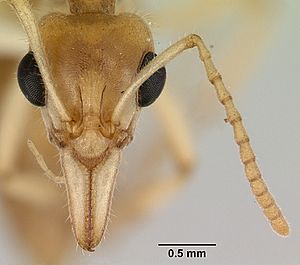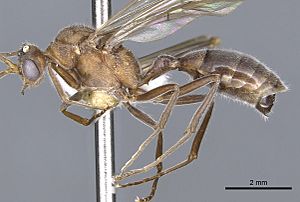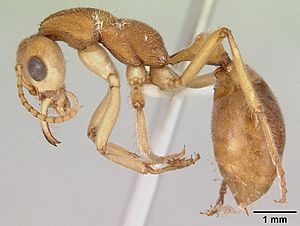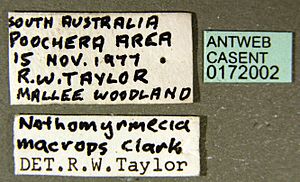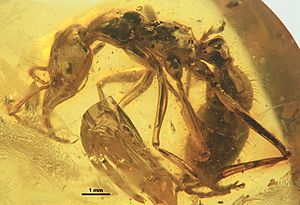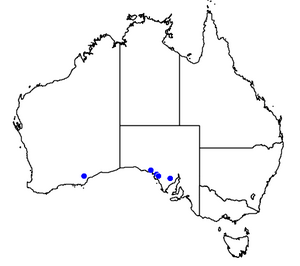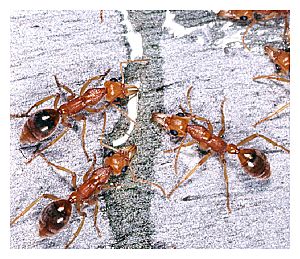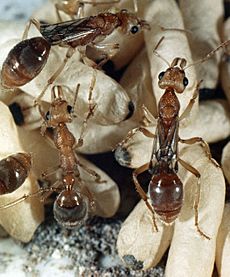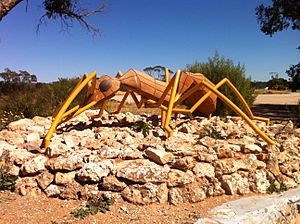Dinosaur ant facts for kids
Quick facts for kids Dinosaur ant |
|
|---|---|
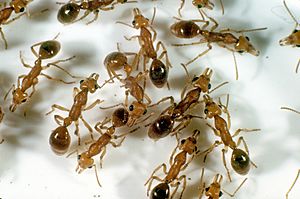 |
|
| N. macrops workers | |
| Conservation status | |
| Scientific classification | |
| Genus: |
Nothomyrmecia
|
| Species: |
macrops
|
The Nothomyrmecia, also called the dinosaur ant or dawn ant, is a very rare type of ant. There is only one known species, Nothomyrmecia macrops. These ants live in South Australia, making their homes in old mallee and Eucalyptus forests.
Scientists don't know exactly how many places these ants live. They might be found in more areas than we currently know, especially if they prefer old forests. Things like losing their homes and climate change could be big dangers to their survival. Nothomyrmecia ants are most active when it's cold. This is because they meet fewer other ants that might compete for food or try to eat them. Cold weather also helps them hunt better. If temperatures get too warm, these ants might not be able to find food, and fewer places would be suitable for them to live. Because of this, the IUCN says the dinosaur ant is Critically Endangered, meaning it's at a very high risk of disappearing.
The Nothomyrmecia is a medium-sized ant, about 9.7–11 mm (0.38–0.43 in) long. All the worker ants look pretty much the same. Their colonies are quite small, with only about 50 to 100 ants in each nest. Worker ants are active only at night and search for food alone. They eat small insects and sweet stuff like honeydew from scale insects. They use their good eyesight to find their way around. They don't seem to use chemical trails to communicate while looking for food, but they do use chemical signals to warn each other of danger. A queen ant will mate with one or more males. When starting a new colony, she hunts for food until her first babies grow up. Queens usually produce only one group of babies each year. Sometimes two queens might start a colony together, but only one will stay once the first worker ants are born.
The Nothomyrmecia was first described by an Australian scientist named John S. Clark in 1934. He found two worker ants collected in 1931 near the Russell Range in Western Australia. After this first discovery, the ant wasn't seen again for 40 years! Then, in 1977, a group of scientists found it again, 1,300 km (810 mi) away from where it was first reported. People called this ant the 'Holy Grail' of myrmecology (the study of ants). Its rediscovery made scientists from all over the world very interested. In Poochera, South Australia, where it was found again, pictures of the ant are painted on the streets. It might be the only town in the world that gets tourists because of an ant! Because of its body shape, the Nothomyrmecia is thought to be the most primitive living ant and is often called a 'living fossil'. This has led to many studies about its body, behavior, and how it lives.
Contents
What the Dinosaur Ant Looks Like
The Nothomyrmecia is a medium-sized ant, about 9.7–11 mm (0.38–0.43 in) long. All the worker ants look very similar. Their jaws, face, antennae, and legs are light yellow. They have many long, yellow hairs all over their body, but the hairs on their antennae and legs are shorter. This ant looks a bit like the Myrmecia ant and somewhat like the Oecophylla, also known as weaver ants.
Worker ants are active only at night. They use their large compound eyes to see and navigate in the dark. Their jaws are shorter than their head and have 10 to 15 teeth. These jaws are not as specialized as those of Myrmecia ants. The ant's head is longer than it is wide and gets wider towards the back. The sides of the head are curved around the eyes. The long base parts of their antennae reach past the back of their head.
The Nothomyrmecia has a long stinger at the back of its body that can be pulled in. It can deliver a painful sting. This ant is special because it's the only known ant species that has both a stinger and a "waist" (a single narrow part) between its main body sections.
Queen ants look similar to workers but are usually bigger. They have well-developed ocelli (simple eyes), but their main eyes are not larger. The queen's wings are very small and cannot be used for flying. Male ants look like Myrmecia males but have a single waist node. Male ants have long, fully developed wings, unlike the queens.
All Nothomyrmecia ants have six mouthfeelers (called maxillary palps) and four other sensory parts (labial palps) near their mouth. This is a very old and primitive feature. Female ants have 12 segments on their antennae, while males have 13.
The eggs of Nothomyrmecia are like those of Myrmecia: roundish and not sticky. The larvae (baby ants) have a simple body structure. They grow through three stages, measuring about 2.8 mm (0.1 in), 6.3 mm (0.2 in), and 11 mm (0.4 in) long. Their cocoons (the cases they spin before becoming adults) have thin walls.
Overall, the body structure of all Nothomyrmecia ants shows how primitive this species is. For example, the workers have tiny, non-working simple eyes, and the queens have very small wings. Scientists are still trying to understand why the queens have these non-functional wings. It might be related to how their populations are structured or how they deal with dry conditions.
How the Dinosaur Ant Was Discovered and Named
Discovery
The first Nothomyrmecia ants were collected in December 1931 by Amy Crocker, an amateur insect enthusiast. Her friends collected two worker ants for her near the Russell Range in Western Australia. Crocker then gave the ants to Australian scientist John S. Clark. He quickly realized they were a new species.
For over 30 years, scientists searched for this ant again in Western Australia but couldn't find it. Famous ant scientists like E. O. Wilson tried but failed. Then, on October 22, 1977, scientist Robert W. Taylor and his team accidentally found a single worker ant in Poochera, South Australia. This was about 1,300 km (810 mi) from where it was first reported! After 46 years of searching, scientists called this ant the 'Holy Grail' of ant studies.
Naming
In 1934, John S. Clark officially described Nothomyrmecia macrops as a new species. He even created a new group (genus) and tribe for it because it looked so different from other ants he knew. It did share some features with an extinct ant called Prionomyrmex.
Over the years, scientists debated where Nothomyrmecia fit in the ant family tree. Some thought it should be in its own special group, while others thought it was closer to Myrmecia ants. In 2000, a scientist named Cesare Baroni Urbani suggested that Nothomyrmecia and the fossil Prionomyrmex were so similar they should be in the same genus. However, most scientists today agree that Nothomyrmecia and Prionomyrmex are distinct but related groups.
The ant is commonly known as the dinosaur ant, dawn ant, or living fossil ant because its body structure is very old and primitive. The name Nothomyrmecia means "false bulldog ant." Its species name, macrops, comes from Greek words meaning "long" or "large" and "eyes," referring to its big eyes.
Genetics and Family Tree
Studies show that Nothomyrmecia has a very high number of chromosomes (92–94), which is among the highest for all insects in its group.
Genetic evidence suggests that Nothomyrmecia and Myrmecia ants shared a common ancestor about 74 million years ago, meaning they likely appeared during the Cretaceous period. Scientists believe Nothomyrmecia probably evolved from ancestors similar to a group of ants called Ponerinae. Nothomyrmecia and other primitive ants behave similarly to some wasps that live in the soil.
Scientists think Nothomyrmecia might be closely related to extinct ants like Avitomyrmex, Macabeemyrma, Prionomyrmex, and Ypresiomyrma.
| Myrmeciinae |
|
|||||||||||||||||||||||||||||||||
Where the Dinosaur Ant Lives
Nothomyrmecia ants live in the cool parts of South Australia. They are found in mallee woodlands, especially in old forests with different types of Eucalyptus trees. It's possible they also live in Western Australia, where they were first found.
Scientists don't know the full area where Nothomyrmecia lives. If they prefer old mallee woodlands, they might be found in more places than we currently know from surveys. In 1998, ant colonies were found in 18 areas along the Eyre Peninsula, covering about 400 km (250 mi).
Their nests are in damaged limestone soil where Callitris trees grow. They only build nests when the soil is wet. The entrance holes to their nests are hard to spot, only about 4–6 mm (0.16–0.24 in) wide. They are hidden under shallow leaf litter, with no dirt piles around them. Guard ants are often seen at the entrance. Inside, a single tunnel about 4–5 mm (0.16–0.20 in) wide goes steeply down into the ground. It leads to a somewhat oval-shaped room, about 3–5 cm (1.2–2.0 in) wide and 5–10 mm (0.20–0.39 in) high. This room is usually 18 to 43 cm (7.1 to 16.9 in) below the ground.
Behavior and Life Cycle
Foraging, Diet, and Predators
Worker ants are nectarivores, meaning they eat nectar. They look for food on Eucalyptus trees, finding food for themselves and prey for the larvae (baby ants). Workers drink the blood-like fluid (hemolymph) from insects they catch. They hunt for small insects like flies, tiny moths, and baby spiders in piles of leaves. They grab their prey with their jaws and front legs, then kill them with their sting.
Workers also eat sweet substances like honeydew, which is made by scale insects. One worker might feed on these sweet sources for 30 minutes. If there's not enough food, they might give pupae (ants in their cocoon stage) to the larvae. Workers can also lay eggs that are not fertilized, just to feed the larvae. Sometimes, adult ants, including the queen, eat these eggs. Workers share food with other ants in the nest, including winged adults and larvae.
Unlike many other ants, younger Nothomyrmecia workers don't just stay in the nest as nurses. Both young and older workers go out to find food. Workers are active only at night and come out of their nests only on cold nights. They are most active when temperatures are 5–10 °C (41–50 °F). It's harder to find them on warmer nights. They are probably more active when it's cold because they meet fewer other ants that might compete with them. Cold temperatures might also make it harder for their prey to escape, helping the ants hunt better.
Workers stay on trees until dawn, possibly using sunlight to find their way back to their nest. They don't seem to use chemical trails to find food. Instead, they use visual clues to navigate. Chemical smells might be important for recognizing nest entrances. These ants search for food alone. They carry waste like dead ants, cocoon shells, and food scraps far away from the nest.
Workers from different Nothomyrmecia colonies don't fight each other. They can even look for food on the same tree. However, they will attack if an outside ant tries to enter their underground colony. Other ants like Camponotus and Iridomyrmex can be a danger to foraging workers or the colony. Nothomyrmecia workers fight back by releasing alarm chemicals from their glands. They also protect themselves by opening their jaws in a threatening way or by falling to the ground and staying still until the danger is gone. However, Nothomyrmecia is generally a shy ant that retreats if it feels exposed.
Life Cycle and Reproduction
Nothomyrmecia ants do not have a nuptial flight (where virgin queens and males fly to mate). Instead, they mate on the ground or on plants. This usually happens in late summer or autumn, with winged adults appearing around March and April. These winged adults are usually quite young when they start to mate. Queens are seen on plants, trying to flutter their tiny, non-flying wings. Because the queen's wings are so small, it's likely that the winged adults mate near their home nest. They might release special smells (pheromones) or climb on plants far from their nests to attract fully winged males.
Nothomyrmecia queens mate with one or more males. In one study, queens mated with about 1.37 males on average. After mating, new colonies can be started by one or two queens. If two queens start a colony, only one will remain once the nest is mature. The queens will compete, and the losing queen is later dragged out of the nest by workers. An existing nest without a queen might adopt a new queen who is looking for a place to start her colony. Queens are semi-claustral, meaning that when they start a new colony, they will go out and find food for themselves and their babies. Sometimes a queen will leave her nest at night just to find food or water.
Eggs are not seen in nests from April to September. They are laid by late December and grow into adults by mid-February. The pupae (ants in cocoons) usually stay in their cocoons over winter and start to hatch when new eggs are laid. Nothomyrmecia is univoltine, meaning the queen produces only one group of eggs per season. It can take up to 12 months for an egg to become an adult.
Workers can lay eggs that can develop into new ants. It's not known if these eggs become males, females, or both. This is because some colonies have a lot of genetic diversity, suggesting that worker ants might be able to mate with males and help with reproduction. Eggs are scattered around the nest, while larvae and pupae are kept in separate groups. Larvae can crawl around the nest. When larvae are ready to spin their cocoons, they swell up and are then buried by workers in the ground to help them form their cocoons. Small, gentle workers act as nurses and help newborn ants hatch from their cocoons. A mature nest might only have 50 to 100 adult ants. In some nests, a new colony can start within the old one: if a queen dies, one of her daughters might take over, or the colony might adopt a newly mated queen. This can make the colony last almost forever.
Relationship with Humans
Conservation
Before it was found again in 1977, scientists worried that Nothomyrmecia had already become extinct. In 1996, the International Union for Conservation of Nature listed Nothomyrmecia as Critically Endangered. They said only a few small colonies were known. However, the Threatened Species Scientific Committee says the species might not need to be listed as endangered under Australian law. This is because there isn't enough proof that their numbers are going down. Also, their colonies are naturally small, and they might live in many more places across southern Australia than we currently know, especially since they like old mallee woodlands. With 18 known sites and possibly many more to be found, it seems unlikely they will go extinct very soon. Still, scientists don't know how widespread the species truly is or what dangers it faces.
Human activities that could harm Nothomyrmecia include destroying and breaking up their habitat with railway lines, roads, and farms. In the town of Ceduna, west of Poochera, local ant populations were almost wiped out when the area was cleared for an underground telephone line. Colonies might not survive tree-clearing because they rely on the tree canopies above to navigate. Bushfires are another big threat, as they can destroy food sources and reduce the ant population. While these ants might have recovered from past fires, larger and more frequent fires could be devastating. Nothomyrmecia ants can be safe from fires if they stay inside their nests.
Climate change could also be a threat. Since they need cold temperatures to find food, an increase in temperature would stop workers from foraging. This would leave very few areas suitable for the species to live in. Cold winds from the Southern Ocean help Nothomyrmecia get the cool temperatures they need for night-time foraging. So, an increase in sea temperature could also threaten them.
Conservationists suggest that doing more surveys, protecting known populations, and fighting climate change can help Nothomyrmecia survive. They also want to protect the remaining mallee habitat and improve the health of trees and undergrowth. Since most known populations are found outside protected areas, often along roads, a special plan is needed. This plan would help local councils understand the ant's presence, its conservation status, and what kind of habitat it needs. This could lead to better decisions about land use at the local level. Not all colonies are in unprotected areas; some have been found in the Lake Gilles Conservation Park and the Chadinga Conservation Reserve. More research is needed to find out how widely these ants are spread.
Significance
Nothomyrmecia macrops is seen as the most primitive living ant, which makes it very interesting to ant scientists. After it was rediscovered, it became one of the most studied ant species on Earth. Nothomyrmecia can be raised easily in labs, which makes it useful for studying how insects learn and how their night vision works.
Since its accidental discovery in Poochera, the town has become famous among ant scientists. It might be the only town in the world that has tourism based on an ant! To promote it as a tourist spot, Nothomyrmecia has become the symbol of the Poochera community. Pictures of the ant are painted on the sidewalks, and a large sculpture of Nothomyrmecia has been put up in the town.
See also
 In Spanish: Hormiga dinosaurio para niños
In Spanish: Hormiga dinosaurio para niños



